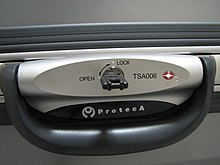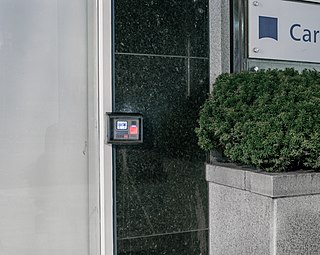
In physical security and information security, access control (AC) is the selective restriction of access to a place or other resource, while access management describes the process. The act of accessing may mean consuming, entering, or using. Permission to access a resource is called authorization.

Lock picking is the practice of unlocking a lock by manipulating the components of the lock device without the original key.

The Transportation Security Administration (TSA) is an agency of the United States Department of Homeland Security (DHS) that has authority over the security of transportation systems within and connecting to the United States. It was created as a response to the September 11 attacks to improve airport security procedures and consolidate air travel security under a combined federal law enforcement and regulatory agency.
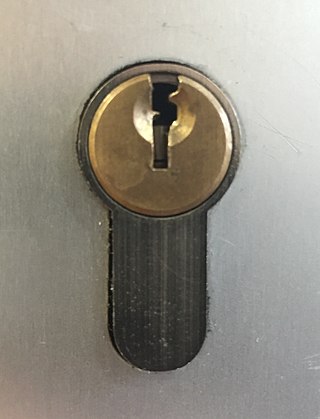
The pin tumbler lock, also known as the Yale lock after the inventor of the modern version, is a lock mechanism that uses pins of varying lengths to prevent the lock from opening without the correct key.

A combination lock is a type of locking device in which a sequence of symbols, usually numbers, is used to open the lock. The sequence may be entered using a single rotating dial which interacts with several discs or cams, by using a set of several rotating discs with inscribed symbols which directly interact with the locking mechanism, or through an electronic or mechanical keypad. Types range from inexpensive three-digit luggage locks to high-security safes. Unlike ordinary padlocks, combination locks do not use keys.

A lock is a mechanical or electronic fastening device that is released by a physical object, by supplying secret information, by a combination thereof, or it may only be able to be opened from one side, such as a door chain.

A lever tumbler lock is a type of lock that uses a set of levers to prevent the bolt from moving in the lock. In the simplest form of these, lifting the tumbler above a certain height will allow the bolt to slide past.
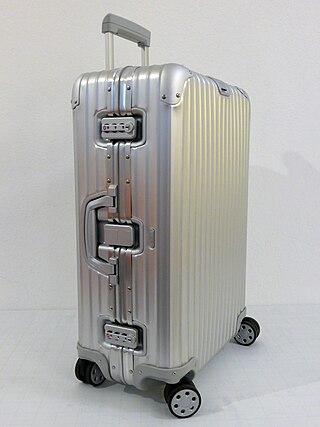
Baggage or luggage consists of bags, cases, and containers which hold a traveler's personal articles while the traveler is in transit. A modern traveler can be expected to have packages containing clothing, toiletries, small possessions, trip necessities. On the return trip, travelers may have souvenirs and gifts. For some people, luggage and the style thereof is representative of the owner's wealth and status. Luggage is constructed to protect the items during travel either with a hard shell or a durable soft material. Luggage often has internal subdivisions or sections to aid in securing items. Handles are typically provided to facilitate carrying, and some luggage may have wheels and/or telescoping handles or leashes to make moving them easier.

Safe-cracking is the process of opening a safe without either the combination or the key.

Padlocks are portable locks with a shackle that may be passed through an opening to prevent use, theft, vandalism or harm.

An electronic lock is a locking device which operates by means of electric current. Electric locks are sometimes stand-alone with an electronic control assembly mounted directly to the lock. Electric locks may be connected to an access control system, the advantages of which include: key control, where keys can be added and removed without re-keying the lock cylinder; fine access control, where time and place are factors; and transaction logging, where activity is recorded. Electronic locks can also be remotely monitored and controlled, both to lock and to unlock.
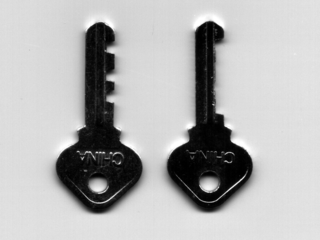
A skeleton key is a type of master key in which the serrated edge has been removed in such a way that it can open numerous locks, most commonly the warded lock. The term derives from the fact that the key has been reduced to its essential parts.
Rekeying a lock is replacing the old lock pins with new lock pins.
Master Lock is an American company that sells padlocks, combination locks, safes, and related security products. Now a subsidiary of Fortune Brands Innovations, Master Lock Company LLC was formed in 1921 by locksmith-inventor Harry Soref and is headquartered in Oak Creek, Wisconsin. In 1970, the company was purchased by American Brands from Soref's heirs. American Brands was later renamed to Fortune Brands, which then split on October 3, 2011, to create the Fortune Brands Home & Security company and the beverages company Beam Inc..
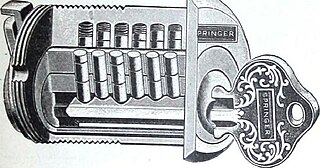
A master key operates a set of several locks. Usually, there is nothing different about the key. The differences are in the locks the key will operate. These master-keyed locks are configured to operate with two, or more, different keys: one specific to each lock, which cannot operate any of the others in the set, and the master key, which operates all the locks in the set. Locks that have master keys have a second set of the mechanism used to operate them that is identical to all of the others in the set of locks. For example, master keyed pin tumbler locks often have two shear points at each pin position, one for the change key and one for the master key. A far more secure system has two cylinders in each lock, one for the change key and one for the master key.
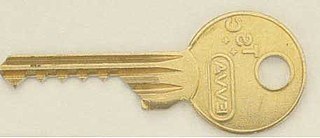
Lock bumping is a lock picking technique for opening a pin tumbler lock using a specially crafted bump key, rapping key or 999 key. A bump key must correspond to the target lock in order to function correctly.

An interchangeable core or IC is an adaptable locking key cylinder, which can be rapidly exchanged in the field via the use of specialized "control keys".

Travel Sentry is a company that develops and licenses standards used in travel security, including a standard for luggage locks that can be opened by aviation security agencies such as the Transportation Security Administration (TSA).

Okoban is a system that allows individuals to register property with pre-assigned unique identification codes in an online database so that, if the property is lost then found, the finder can notify the registrant.
This is a glossary of locksmithing terms.
